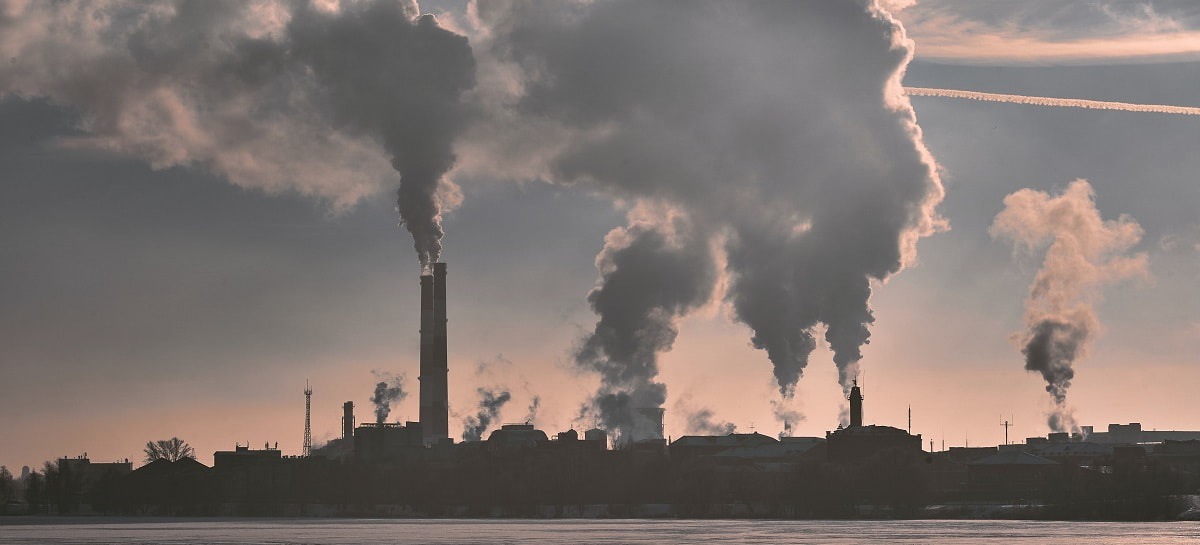Nearly everything humans do has the capability to produce pollution and release it into the environment.
Simple tasks you don’t often think about, like pumping gas, turning on a light, spraying insect repellent, and buying meat or dairy at the grocery store, seem insignificant. You may not think twice about them as you go through your day.
But they each contribute to pollution and can damage our environment, to some degree. And, when added up, they all hurt our chances of fighting climate change and meeting the UN SDGs, which, in turn, can negatively affect all living things on the planet.
In this guide, we’re going to discuss pollution. Specifically: point source pollution and nonpoint source pollution. We’ll explain the definition of each, give you some nonpoint and point source pollution examples, and give you some tips for helping out.
Scroll down below to start learning more about point and nonpoint source pollution and how you can prevent it!

Want to Improve Yourself Each Day?
Sign up to Goodwall!
- Connect with improvement-focused people from 150+ countries
- Build valuable skills and experience
- Ask questions and get support when you need it
Download the app now to get started for FREE!
A Quick Pollution Overview
Human pollution has followed us around since the beginning of human history, obvs. However, it’s been mostly inconsequential until just recently, in the past century or two. Since then, overpopulation, industrial movements, and technological advancements have driven pollution to become one of the most significant environmental issues worldwide. It’s also become one of the largest causes of disease and premature death, as these contaminants flow through many food sources.
The cost of our success is the exhaustion of natural resources, leading to energy crises, climate change, pollution, and the destruction of our habitat. If you exhaust natural resources, there will be nothing left for your children. If we continue in the same direction, humankind is headed for some frightful ordeals, if not extinction.
Christian de Duve (taken from our list of Earth Day quotes)
In an attempt to better understand its impact, regulatory agencies who oversee the environment’s safety categorize the crisis into two types of pollution: nonpoint source pollution and point source pollution.
Both of these types of pollution affect our water, air, and the overall fragile state of our ecosystem. In an attempt to contain the damage, many countries adopted laws. In the United States, for example, we have the Clean Water Act, which regulates the discharge of pollutants into national waters and regulates quality standards for surface waters.
What Is Point Source Pollution?
Point source pollution is a reference to pollutants that are traceable back to one specific single source. Point source pollutants have a particular someone or something at fault and liable, and, usually, the contaminants which enter the environment come from a place that can be easily confined and controlled.
Point source pollutants are present in the air and in the water. Here are some point source pollution examples that you may be exposed to:
Point Source Water Pollution
Factories and power sewage plants are some of the largest contributors to point source water pollution. Paper mills and automotive plants tend to use water as a part of their manufacturing process, and, as a result, they often discharge chemicals with their wastewater. That wastewater then flows and merges back into your local lakes, rivers, and ocean.
Wastewater treatment centers are also big point sources of pollutants in the water because they expose nutrients and microbes to local waterways. As a result, algae and bacteria in the water can flourish. Concentrated animal feeding operations contribute to point source pollution when they do not pick up and maintain the animal’s waste. All of the waste builds up and leads to raw sewage trickling into nearby waterbodies.
The same can be said for farms and agriculture facilities that spray their land with pesticides. Although ridding themselves of pests that harm the vegetation, the health risks from runoff of the chemical-treated farmlands into public waterbodies outweigh the need. Pesticides cause such a risk that world organizations banned using a pesticide called DDT after biologist Rachel Carson wrote about its effects on human health in her book Silent Springs.
This recognizes the pivotal moment in time that started point source pollution regulation.
Point Source Air Pollution
Point source air pollution can usually trace back to a specific factory or plant that releases fossil fuels, smoke, and other emissions, really anything which can be inhaled and sent into the atmosphere. In this category, industrial smokestacks admittedly produce many pollutants that affect the earth’s ozone layer. They emit carbon monoxide, heavy metals, and even sulfur dioxide into your breathing air.
On a smaller scale, you can find air pollution examples in things you see regularly, such as vehicles using gas fuels to go from one place to another, bringing the risks much closer to home. You may even consider a single cigarette to be included in the definition of point source pollution, though it’s usually meant to refer to more substantial sources.
Nonpoint Source Pollution
What Is Nonpoint Source Pollution?
The second category, nonpoint source (NPS) pollution, has many more variables. The nonpoint source pollution definition is the contamination of the air or water without a single identifiable origin.
Nonpoint pollution often releases contaminants into a wider area as a result of natural interferences that are not able to be controlled. Because of the difficulty in identifying a specific source, this type of pollution is also harder to regulate and mitigate, unfortunately, which means we must be even more aware if we’re to make a difference.
Nonpoint Source Water Pollution
Unlike point source pollutants, government agencies have a harder time regulating how much of it ends up in the waterways due to natural runoff. You can identify polluted water from its dirty coloring, bad odors, and the more obvious pieces of trash floating in it.
With an increase in plastic and non-biodegradable item production, the trash that lands in the ocean will often stay there for hundreds of years before it begins to break down. The trash is consumed by fish and wildlife, which, in turn, ends up on the tables of thousands of people who eat seafood. This goes to show you how no living thing is immune from pollution.
Water pollution can happen naturally as well. Oils and natural gases from the earth can leak into oceans from underground sources right below them, such as with petroleum seeps. The world’s largest petroleum seep is the Coal Oil Point Seep, located off the California coast. This petroleum seep releases so much oil that tar balls, sticky dark blobs of petroleum, wash up on nearby beaches and eventually decompose in the ocean.
Nonpoint Source Land Pollution
Local environmental agencies hold point source polluters accountable when over their percentage of acceptable regulations, but what happens when the land pollution is naturally produced? The tar balls mentioned previously make their way from the ocean and onto local beaches and must be cleaned up with great efforts that involve extensive beach digging and sand replacement.
The same trash that litters the waters also causes pollution on land. Ineffective garbage collection systems and natural runoff contribute to this. The trash can be dispersed and relocated miles away from the source. Piles of it prevent local plants from producing the proper nutrients needed to sustain life. It’s also deadly for local wildlife that confuses the trash in food.
Nonpoint Source Air Pollution
Some nonpoint air pollutants have been around long before humans. Pollutants like volcanoes emit ash and volcanic gases into the air that can contaminate it and may be deadly if inhaled.
Uncontrolled deforestation around the world has led to an increase in greenhouse gases such as methane. Though necessary for life on earth, too much is causing the earth to heat up and contribute to our climate change.
Is There a Point Source Solution to All This?
It’s easy to feel overwhelmed with all the abundance of information; after all, what can you do as one person? The good news is you are not alone. World organizations are raising awareness of the rising dangers of point source and nonpoint source pollution as more people see the effects firsthand.
Simple lifestyle changes can help you make an impact and allow us to better control the damage caused by all kinds of pollution. Here are a few ways to get started:
1. Raise Awareness
Raising awareness and getting the word out is the best defense against these two types of pollution. The more people know, the more hands are out there cleaning up and doing their part. Be a good example and always recycle!
I want you to act as if the house is on fire, because it is.
Greta Thunberg (taken from our list of environment quotes)
2. If You See It, Clean It
Keep your outside storm drains and other areas you see free of pet waste, trash, and debris. These pollutants can easily flow back into local rivers, lakes, and streams and contaminate them.
3. Clean Up Chemicals
After refilling your car fluids, make sure to clean up any excess antifreeze and oil spills. Refrain from hosing it down your driveway to prevent chemical runoff into the soil or local water supply.
4. Donate Your Time
It can seem impossible to find ways to solve both nonpoint source and point source pollutants. But, donating your time is a great way to help the Earth. Plant some plants and trees, or volunteer in your spare time to help out at a local garden or park. You might just help prevent the next major forest fire.
I urge young people to consider public service, whether they do it now by volunteering in their community or prepare for public service as an adult.
John Walters (taken from our list of volunteering quotes)
Here’s the Point
The longer humans wait to undo the damage, the more the damage becomes irreversible.
Knowing about the different types of point source pollution and nonpoint source pollution is the first step. The next step is taking action.
It’s never too late to do your part!



